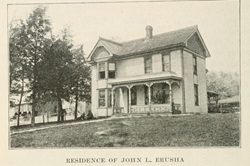| Many
young men of today who chose farming as an occupation realize that in
this career are to be found great possibilities for individual effort
and enterprise. This line of work is carried on more in
accordance with scientific methods from year to year and the modern
farmer is an able business man, carefully planning every detail of his
operations. One of the younger farmers of Johnson county is John L.
Erusha who has spent his life on the farm in Monroe township, where he
was born March 13, 1889. He is the son of John R. and Frances
(Novatny) Erusha, the former a native of Bohemia. John R. Erusha came
to America with his parents when a child and the family located
permanently in Johnson county. Frances Novatny was born in Iowa county,
her parents being natives of Bohemia, who came to Iowa at an early day.
John R. and Frances Erusha had three children: John L., on the
home farm; Edward, not at home; and Melver, attending school. | 
Click image to enlarge |
John L. Erusha as educated in local schools and as soon as he was old
enough helped with the work on his father's farm. He purchased the old
homestead in July, 1911, and there carries on general farming and stock
raising. He has made many friends in the community and has a good
standing with his neighbors and associates. He is a member of the
Catholic church and is independent in political affairs, preferring to
vote for the men and measures he believes will best serve the
interests of the public rather than be bound by party rules. He is
popular in social circles and active in various movements for the
improvement of conditions in the community, being interested in the
work of the church and in local issues. On November 28, 1911, Mr.
Erusha was united in marriage to Miss Barbara Svoboda, daughter of
Andrew and Barbara (Jindrich) Svoboda, both natives of Bohemia.
Source: Leading Events in Johnson County, IA, Cedar Rapids, Western Historical Press 1912-13; pg. 565)
|